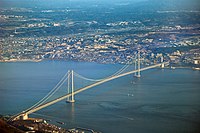
Photo from wikipedia
Abstract This paper presents a framework for the fatigue analysis of stay cables under combined action of traffic and wind. The North Channel Bridge (NCB) of Hangzhou Bay Bridge in… Click to show full abstract
Abstract This paper presents a framework for the fatigue analysis of stay cables under combined action of traffic and wind. The North Channel Bridge (NCB) of Hangzhou Bay Bridge in China was used as an example for demonstration. The bridge model and the stress influence surface of stay cables were established first and then the coupled wind-vehicle-bridge system was developed. Considering the multiple random vehicles on the bridge, a simplified approach was proposed and verified for the stress calculation of stay cables under the combined loads. This simplified approach using the stress influence surface and considering the vehicle as a whole is much more efficient than the coupled dynamic analysis. The databases under individual load were then established to generate the stress time histories of all the stay cables. Finally, the fatigue analysis was performed and the cumulative fatigue damage considering the random traffic and wind was calculated. The results show that the combined actions of different loads should be considered in the analysis. An increase of the equivalent stress range and a decrease of the stress cycles are also found with the increase of daily traffic volume.
Journal Title: Engineering Structures
Year Published: 2020
Link to full text (if available)
Share on Social Media: Sign Up to like & get
recommendations!